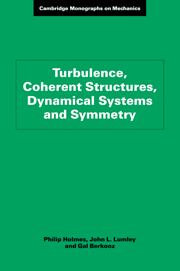10 - Behavior of the models
Published online by Cambridge University Press: 03 February 2010
Summary
In this chapter we shall describe the qualitative structure, in phase space, of some of the low-dimensional models derived in the preceding chapter. We will also discuss the physical implications of our findings. Drawing on the material introduced in Chapters 5–8, we shall solve for some of the simpler fixed points (steady, time-independent flows and travelling waves) and discuss their stability and bifurcations under variation of the loss parameters αj introduced in Section 9.1. We focus on the five mode model (N = 1, K1 = 0, K3 = 5) introduced in the original paper of Aubry et al., and referred to there as the “six mode model,” the k3 = 0 mode being implicitly included in the model of the slowly varying mean flow. The full range of dynamical behavior of even such a draconian truncation as this is bewilderingly complex and still incompletely understood, but we are able to give a fairly complete account of a particular family of solutions – attracting heteroclinic cycles – which appear especially relevant to understanding the burst/sweep cycle which was described in Section 2.5.
In Sections 10.1 and 10.2 we use the nesting properties of invariant subspaces, noted in Section 9.5, to solve a reduced system, containing only two (even) complex modes, for fixed points. We exhibit the bifurcation diagram and discuss the stability of a particular branch of fixed points corresponding to streamwise vortices of the appropriate spanwise wavenumber.
- Type
- Chapter
- Information
- Turbulence, Coherent Structures, Dynamical Systems and Symmetry , pp. 315 - 346Publisher: Cambridge University PressPrint publication year: 1996

